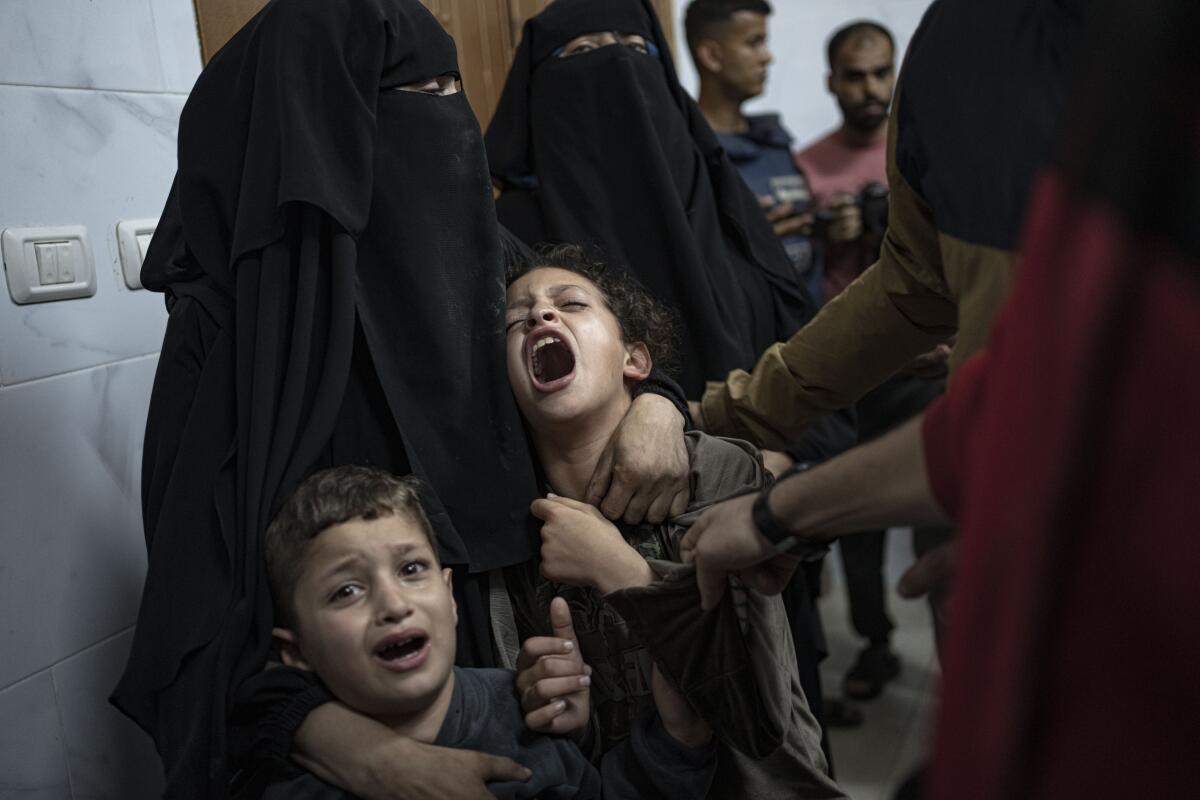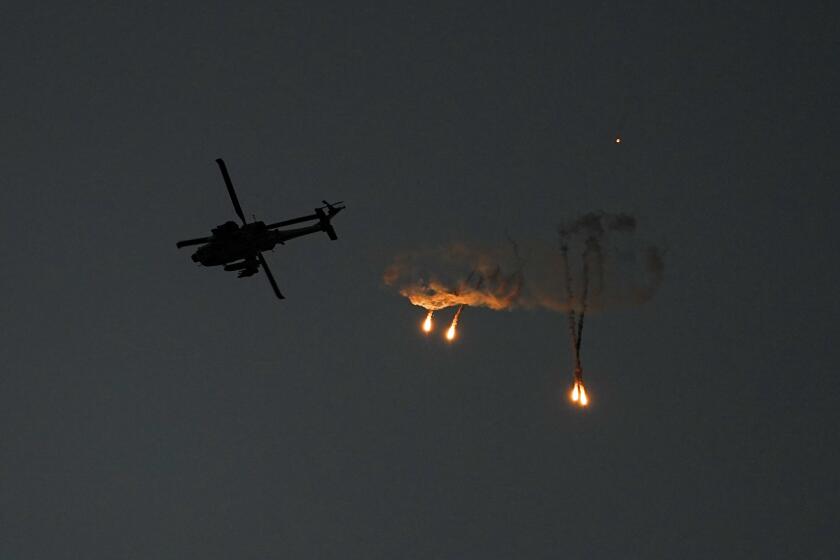Netanyahu rejects growing calls for a cease-fire as Israel battles Hamas outside main Gaza hospital

- Share via
DEIR AL BALAH, Gaza Strip — Israeli Prime Minister Benjamin Netanyahu on Saturday rejected growing international calls for a cease-fire, saying Israel’s battle to crush Gaza’s ruling Hamas militants will continue with “full force.”
A cease-fire would be possible only if all 239 hostages held by the militants in Gaza are released, Netanyahu said in a televised address.
The Israeli leader also insisted that after the war, now entering its sixth week, Gaza would be demilitarized and Israel would retain security control there. Asked what he meant by security control, Netanyahu said Israeli forces must be able to enter Gaza freely to hunt down the militants, who on Oct. 7 launched an attack into southern Israel, killing at least 1,200 people, most of them civilians, and taking those kidnapped back to Gaza.
He also rejected the idea that the Palestinian Authority, which currently administers autonomous areas in the Israeli-occupied West Bank, would at some stage control Gaza. Both positions run counter to postwar scenarios floated by Israel’s closest ally, the United States.
Secretary of State Antony J. Blinken has said the U.S. opposes an Israeli reoccupation of Gaza and envisions a unified Palestinian government in both Gaza and the West Bank at some stage as a step toward Palestinian statehood.
For now, Netanyahu said, “the war against [Hamas] is advancing with full force, and it has one goal, to win. There is no alternative to victory.”
The Health Ministry, which does not differentiate between civilian and militant deaths, said that more than 11,070 Palestinians have been killed since the war began.
Pressure was growing on Israel after frantic doctors at Gaza’s largest hospital said the last generator had run out of fuel, causing the death of a premature baby, another child in an incubator and four other patients. Thousands of war-wounded, medical staffers and displaced civilians were caught in the fighting.
In recent days, fighting near Shifa and other hospitals in northern Gaza has intensified and supplies have run out.
The Israeli military has said, without providing evidence, that the militant group Hamas has established command posts in and underneath hospitals, using civilians as human shields. Medical staffers at Shifa have denied such claims and accused Israel of harming civilians with indiscriminate attacks.
Shifa hospital director Muhammad Abu Salima said the facility lost power Saturday.
“Medical devices stopped. Patients, especially those in intensive care, started to die,” he said, speaking by phone over the sound of gunfire and explosions.
Abu Salima said Israeli troops were “shooting at anyone outside or inside the hospital,” and prevented movement between the buildings in the compound.
The claim that Israeli troops were the sole source of fire could not be verified independently.
A Times special correspondent in Gaza offers a personal account of living in a place where nowhere feels safe.
Israel’s military confirmed clashes outside the hospital, but Rear Adm. Daniel Hagari denied Shifa was under siege. He said troops will provide assistance Sunday in moving babies treated there and said that “we are speaking directly and regularly” with hospital staff.
Amos Yadlin, a former head of Israeli military intelligence, told broadcaster Channel 12 that as Israel aims to crush Hamas, taking control of the hospitals would be key but require “a lot of tactical creativity,” without hurting patients, other civilians and Israeli hostages.
Six patients died at Shifa after the generator shut down, including the two children, said Medhat Abbas, a spokesman for the Hamas-run Gaza Health Ministry.
The “unbearably desperate situation” at Shifa must stop now, the director general of the International Committee of the Red Cross, Robert Mardini, said on social media. United Nations humanitarian chief Martin Griffiths posted that “there can be no justification for acts of war in health care facilities, leaving them with no power, food or water.”
Elsewhere, the Palestinian Red Crescent said Israeli tanks were 65 feet from Al Quds Hospital in Gaza City, causing “a state of extreme panic and fear” among the 14,000 displaced people sheltering there.
Netanyahu said the responsibility for any harm to civilians lies with Hamas, repeating that the militant group uses civilians in Gaza as human shields. He said that while Israel has urged civilians to leave combat zones, “Hamas is doing everything it can to prevent them from leaving.”
His statements came after French President Emmanuel Macron pushed for a cease-fire and urged other leaders to join his call, telling the BBC there was “no justification” for Israel’s ongoing bombing.
Israel’s military has said soldiers have encountered hundreds of Hamas fighters in underground facilities, schools, mosques and clinics during fighting in Gaza. Israel has said a key goal of the war is to crush Hamas, the militant group that has ruled Gaza for 16 years.
A Hamas official denied that its fighters opened fire at residents trying to leave Gaza City or its hospitals. Speaking by phone, Ghazi Hamad called such assertions by Israel lies and said Hamas doesn’t have guards at hospital gates to prevent people from entering or leaving.
The spokesman of the Hamas military wing said militants were ambushing Israeli troops and vowed that Israel will face a long battle. The Qassam Brigades spokesman, who goes by Abu Obaida, acknowledged in audio aired on Al Jazeera that the battle is disproportionate “but it is terrifying the strongest force in the region.”
Following Hamas’ deadly Oct. 7 attack, Israel’s allies have defended the country’s right to protect itself.
But now into the second month of war, there are growing differences in how many feel Israel should conduct its fight.
The U.S. has been pushing for temporary pauses that would allow for wider distribution of badly needed aid to civilians in the besieged territory where conditions are increasingly dire. Israel has so far agreed to only brief daily periods during which civilians are able to flee the area of ground combat in northern Gaza and head south on foot along the territory’s main north-south artery.
Since these evacuation windows were first announced a week ago, more than 150,000 civilians have fled the north, according to U.N. monitors. On Saturday, the military announced a new evacuation window, saying civilians could use the central road and a coastal road.
On the main road, a steady stream of people could be seen heading southward, clutching children and bags of belongings. Many were on foot and some on donkey-drawn carts. One man pushed two children in a wheelbarrow.
“I am diabetic, and I have blood pressure issues. Where to go, and what do they want from us?” said Yehia Kafarnah, a resident fleeing south.
Palestinian civilians and rights advocates have pushed back against Israel’s portrayal of the southern evacuation zones as “relatively safe,” noting that Israeli bombardment has continued across Gaza, including airstrikes in the south that Israel says target Hamas leaders but that have also killed women and children.
A 57-nation gathering of Muslim and Arab leaders in Saudi Arabia called in their communique for an end to the war in Gaza and the immediate delivery of humanitarian aid. The statement also called on the International Court of Justice, a U.N. organ, to open an investigation into Israel’s attacks, saying the war “cannot be called self-defense and cannot be justified under any means.”
Iran’s President Ebrahim Raisi called on participants to end cooperation, including trade, with Israel.
“The sole solution to the Palestinian cause is resistance,” he told the gathering.
Demonstrations and outrage continued. Police said 300,000 Palestinian supporters marched peacefully in London, the largest such event there since the war started. Right-wing counterprotesters clashed with police.
Thousands of Gaza civilians had been sheltering in the Shifa compound in recent weeks, but many fled Friday after several nearby strikes in which one person was killed and several were wounded.
Tens of thousands more remain in northern Gaza, many sheltering at hospitals and overcrowded U.N. facilities.
Abbas, the Health Ministry spokesman, told the satellite television channel Al Jazeera that there are still 1,500 patients at Shifa, along with 1,500 medical personnel and between 15,000 and 20,000 people seeking shelter.
“Shelling and explosions never stopped,” said Islam Mattar, one of thousands sheltering at Shifa. “Children here are terrified from the constant sound of explosions and the scenes they are watching.”
The U.S. and Israel have diverging views on what a postwar Gaza should look like. Netanyahu and military leaders have said this needs to be dictated solely by Israel’s security needs, such as ensuring that no threats emerge from the territory.
Blinken, speaking to reporters Friday during a tour of Asia, laid out what he said were fundamental principles for a postwar Gaza, some of which seemed to run counter to Israel’s approach.
Blinken said these principles include “no forcible displacement of Palestinians from Gaza, no use of Gaza as a platform for launching terrorism or other attacks against Israel, no diminution in the territory of Gaza, and a commitment to Palestinian-led governance for Gaza and for the West Bank, and in a unified way.”
Concern has grown in recent days as fighting through the dense neighborhoods of Gaza City has come closer to hospitals.
The Hamas-run Interior Ministry said six people were killed early Saturday in a strike on the Nuseirat refugee camp that hit a house. The camp is in the southern evacuation zone.
About 250,000 Israelis have been forced to evacuate from communities near Gaza and along the northern border with Lebanon, where Israeli forces and Hezbollah militants have traded fire repeatedly.
“Hezbollah is dragging Lebanon into a possible war,” Israeli Defense Minister Yoav Gallant said after meeting with soldiers stationed along the border.
More to Read
Sign up for Essential California
The most important California stories and recommendations in your inbox every morning.
You may occasionally receive promotional content from the Los Angeles Times.










